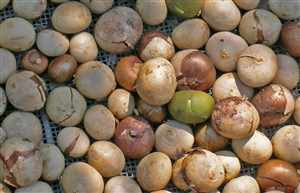Ramón (Brosimum alicastrum), Mayan Bread Nut, Bread Nut
Main Facts about Ramón

Using Ramón
The fruits have zero fat and are gluten-free, and are used to make gluten-free flours. The ramón nut is extremely high in fiber, calcium, potassium, folate, iron, zinc, protein and vitamins A, B, C and E, and antioxidants that prevent cardiovascular disease, strokes, and cancer. The nuts contain tryptophan which is a relaxing agent that helps fight insomnia. In addition, it also increases serotonin levels which in turn helps elevate mood and fight depression. Containing vital nutrients, they are good for infants and pregnant woman. Ramón has a low glycemic index (below 50), making it a good food for diabetics or people watching their sugar and carbohydrate intake. It stabilizes blood sugar and lowers cholesterol in addition, also fiber helps with constipation and gives you a full feeling thereby helping you eat less. The sap from the tree was used by the Mayans to cure stomach and digestive problems, to detoxify the liver and promote lactation in nursing women.Ramón is a remedy for: Anxiety, Constipation
Cooking with Ramón
The entire plant is edible. The leaves and the whole fruit can be eaten right off the tree. The nuts and leaves make a tasty caffeine-free coffee substitute with a chocolate flavor. When dried, the nuts can be stored for up to 5 years without spoiling. They taste similar to a potato and can be eaten raw, boiled or roasted; combined with corn, they create the foundation for many baked goods, including cookies and tortillas. Fresh ramón seeds can be eaten raw, boiled like potatoes, or set out to roast in the sun to be eaten later. The dry seed can be ground into a meal for porridge or flatbread. Ramón seeds do not contain tree allergens like almonds, walnuts and pecans.How to grow Ramón
Indigenous to parts of Central America, South America and the Caribbean, the ramón tree is found in tropical rainforests, deciduous tropical forests, thorn scrub and hillside forests. It tolerates rocky, dry, alkaline, sandy or heavy soils. Though it is native to moist forests, it is unique for its tolerance of drought conditions. One adult tree can produce up to 800 lb of food per year and will remain productive for more than 100 years.| Quinoa |
Rhodiola
|